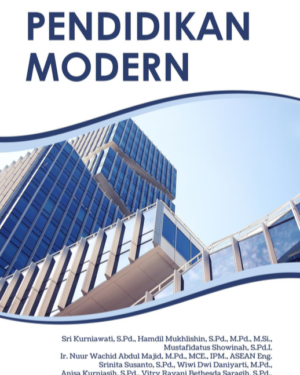EASY ENGLISH BASIC FOR ISLAMIC HIGHER EDUCATION
Rp98.000 Original price was: Rp98.000.Rp75.000Current price is: Rp75.000.
Penulis :
Pipit Muliyah, M.Pd
ISBN : 978-623-8686-67-4
Jumlah Hlm : x + 192
Ukuran : 15×23 Unesco
Kertas : Bookpaper
Tahun Terbit : 2024
Editor : –
SINOPSIS
“Easy English Basic for Islamic Higher Education” is a comprehensive guide tailored for students in Islamic higher education. This book focuses on simplifying English language learning by incorporating Islamic contexts, making it relevant and engaging for learners. It covers fundamental English language skills essential for academic success, such as vocabulary building, grammar rules, and effective communication strategies. Through a structured approach and practical exercises, students can enhance their English proficiency while staying connected to their Islamic principles. With a blend of language learning and cultural sensitivity, this book aims to equip students with the language skills needed to excel in their academic pursuits within an Islamic educational framework. “Easy English Basic for Islamic Higher Education” serves as a valuable resource for students seeking to strengthen their English language abilities in alignment with their Islamic educational goals.
Daftar Isi
Introduction ………………………………………………………………………………………………………….. v
Part I Introduction to English Grammar ……………………………………………………..11
• Chapter 1 Introducing yourself………………………………………………………..12
• Chapter 2 Introducing others ………………………………………………………….14
• Chapter 3 Telling more about yourself…………………………………………..16
Part II Pronouns and Sentence Structure …………………………………………………….18
• Chapter 4 Pronouns in English …………………………………………………………19
• Chapter 5 Subject pronouns ……………………………………………………………..21
• Chapter 6 Object pronouns (me, you, them, us, him, her, it)……23
• Chapter 7 How to use possessive pronouns……………………………….25
• Chapter 8 Subject pronoun and object pronoun………………………..27
• Chapter 9 How to use mine and my?……………………………………………..29
• Chapter 10 Sentences in English…………………………………………………….31
• Chapter 11 Sentence in English (nominal sentence)………………..34
• Chapter 12 Sentence in English (verbal sentence)…………………..36
• Chapter 13 Terms used when learning English grammar…………38
• Chapter 14 Linking verbs …………………………………………………………………40
• Chapter 15 Subject and verbs agreement ……………………………………43
• Chapter 16 Plural noun………………………………………………………………………45
• Chapter 17 Passive and active sentences……………………………………..47
• Chapter 18 Not all noun can be the subject of the sentence ……..49
Part IV Verb Tenses ……………………………………………………………………………………………51
• Chapter 33 Understand how to use present progressive…………52
• Chapter 34 Understanding how to use past progressive ………..53
• Chapter 35 Not all verbs can be used in progressive tenses….55
• Chapter 36 See, look at, watch,………………………………………………………..57
• Chapter 37 Hear and listen to…………………………………………………………59
• Chapter 38 How to use think about and think that ……………………..60
Chapter 39 How to use would like…………………………………………………62
• Chapter 40 Would like + infinitive …………………………………………………64
• Chapter 41 Would like vs like………………………………………………………….66
• Chapter 42 Count and noncount nouns………………………………………….67
• Chapter 43 Using an vs a …………………………………………………………………..69
• Chapter 44 Measurements with non-count nouns……………………..71
• Chapter 45 Using many, much, a few a little ……………………………….73
• Chapter 46 Using the…………………………………………………………………………75
• Chapter 47 Using no article……………………………………………………………..77
• Chapter 48 Using some and any ……………………………………………………..79
Part V Past Tense and Future Time ………………………………………………………………..80
• Chapter 49 Using Be with past tense……………………………………………81
• Chapter 50 Using be with past tense: negative sentences…….83
• Chapter 51 How to ask questions Using past of be …………………85
• Chapter 52 Simple past tense – using –ed …………………………………87
• Chapter 53 Past tense practice – making past tense verbs……..89
• Chapter 54 Past verb pronunciation practice. ……………………………92
• Chapter 55 Past time words: yesterday, last and ago…………………94
• Chapter 56 Negative simple past…………………………………………………….96
• Chapter 57 Asking question with past tense………………………………..98
• Chapter 58 Asking questions with question words +
helping verbs ………………………………………………………………………………………..99
• Chapter 59 Using before and after in time clause……………………..101
• Chapter 60 Using when in time clauses. …………………………………….103
• Chapter 61 The present progressive and the past
progressive…………………………………………………………………………………………105
• Chapter 62 Using while with the past progressive…………………….107
• Chapter 63 Past tense and past progressive tense…………………..109
• Chapter 64 Using Be going to ……………………………………………………….112
• Chapter 65 Using present progressive to express future time.114
• Chapter 66 Words used for past time and future time …………….116
Chapter 67 Using (a couple of) or (a few) with past
and future……………………………………………………………………………………………118
• Chapter 68 Using will for future time ………………………………………….120
• Chapter 69 Asking question with will…………………………………………123
• Chapter 70 Verb summary ……………………………………………………………..125
• Chapter 71 Form of be verb summary ………………………………………..127
Part VI Past Tense and Future Time…………………………………………………………….129
• Chapter 72 May/might vs will ……………………………………………………..130
• Chapter 73 Maybe and May Be……………………………………………………..133
• Chapter 74 Clauses with if …………………………………………………………….135
• Chapter 75 Expressing habitual present with time clauses
and if-clauses…………………………………………………………………………………….137
• Chapter 76 Using what + forms of Do…………………………………………139
• Chapter 77 Using can………………………………………………………………………142
• Chapter 78 How to pronounce can and can’t ……………………………144
• Chapter 79 Using could: past of can ……………………………………………146
• Chapter 80 Using be able to …………………………………………………………148
• Chapter 81 Using two, too and to…………………………………………………150
• Chapter 82 Using should ……………………………………………………………….152
• Chapter 83 Using have/has to………………………………………………………154
• Chapter 84 Using must ……………………………………………………………………157
• Chpter 85 Using may I, could I, and can I ………………………………….159
• Chapter 86 Could you and would you …………………………………..161
• Chapter 87 Imperative sentences………………………………………………..162
• Chapter 88 How to use modal auxiliaries…………………………………..165
• Chapter 89 Recap the modal auxiliaries and similar
expression…………………………………………………………………………………………..167
Part VII Prepositions, Questions, and Articles …………………………………………..169
• Chapter 19 Preposition of time ……………………………………………………170
• Chapter 20 Preposition of place…………………………………………………..172
• Chapter 21 Prepositions of place (extra) ………………………………….175
• Chapter 22 Yes/no questions with Be………………………………………177x
• Chapter 23 Question with Be + WH words………………………………..179
• Chapter 24 Using have and has ……………………………………………………181
• Chapter 25 Using have and has with past participle ……………….183
• Chapter 26 Using adjectives and noun………………………………………..185
• Chapter 27 Adverbs and adjectives …………………………………………….188
• Chapter 28 How to use very and too…………………………………………..190
• Chapter 29 Using the simple present ………………………………………….192
• Chapter 30 Using adverb of frequency……………………………………….194
• Chapter 31 Using adverb of frequency with BE…………………………197
• Chapter 32 How to spell and pronounce verbs with final –es.199
Produk Serupa
Related products
-
FARMAKOEKONOMI
Rp98.000Original price was: Rp98.000.Rp80.000Current price is: Rp80.000. -
PENDIDIKAN MODERN
Rp98.000Original price was: Rp98.000.Rp80.000Current price is: Rp80.000. -
MANAJEMEN UMKM
Rp98.000Original price was: Rp98.000.Rp80.000Current price is: Rp80.000. -
KURIKULUM DAN PENDIDIKAN
Rp98.000Original price was: Rp98.000.Rp80.000Current price is: Rp80.000. -
MEDIA MEDIA PEMBELAJARAN
Rp98.000Original price was: Rp98.000.Rp80.000Current price is: Rp80.000. -
BIOLOGI DASAR
Rp98.000Original price was: Rp98.000.Rp80.000Current price is: Rp80.000.







